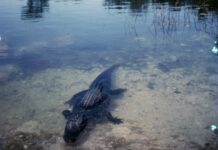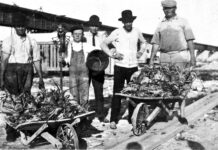You can thank arsenic poisoning next time you enjoy a slice of Key lime pie. That’s what set physician and horticulturist Dr. Henry Perrine on a path to be the first person to introduce and cultivate Key limes in the Florida Keys.
Perrine was born in New Jersey on April 5, 1797 to parents with French Huguenot ancestry. He took an interest in medicine at a young age, and by the time he was 22, Henry moved to Illinois, where he practiced the trade for 5 years. In 1821, Perrine was accidentally poisoned by arsenic and nearly died. He never fully recovered, but warmer climates helped ease the lingering symptoms, so in 1824 he headed south to Natchez, Mississippi. Natchez had a malaria problem, and Perrine set about studying plants and herbs in hopes of finding a cure. His quinine research there became an important source in the medical world for over 100 years. It also scored him an appointment as United States Consul in Campeche, Mexico. It was in Campeche that he would encounter his first limes.
Perrine was enthralled by the variety of botanicals in Campeche. Shortly after his arrival, the United States Treasury Department asked all U.S. consuls to find useful plants for introduction to the United States. Perrine was the only consul to do it, and soon the newspapers in the United States were reporting regularly on his progress.
Perrine believed that the southern tip of Florida was the only suitable place for tropical plants to thrive. He corresponded with Key West Mayor William Whitehead, and began sending seeds and plant samples to Indian Key postmaster Charles Howe. In 1838, Perrine was awarded a survey township in South Florida that he had long petitioned for. The same year, he started the Tropical Plant Company with Charles Howe and Judge James Webb of Key West. Various documents credit him with the introduction of Sisal hemp, sugar cane, pimento, sugar apple, sour sop, avocado, mango, banana, orange, grapefruit and, of course, our beloved limes, to the United States and Florida during this time. The significance cannot be overstated.
Perrine took up residence with his family on Indian Key, bringing with him a large trunk of seeds from Campeche. He grew limes here, and records show him planting a nursery on Lower Matecumbe Key, introducing his limes and other exotic plants to each neighboring key he visited. The limes were noted to thrive without human care. Eventually, they would become known as Key limes, creating a valuable local industry and providing the ingredient that gave name to our world-famous Key lime pie.
Sadly, Perrine would not be around to enjoy the fruits of his labor.
On Aug. 7, 1840, the Second Seminole War came to Indian Key. Native Americans under the charge of Chief Chekika attacked the island in an early-morning ambush. Dr. Perrine ushered his family through a trap door in their living room floor to hide in the turtle crawl below. He pushed his seed trunk across the trap door after them to conceal the entry. Dr. Perrine tried to reason with the attackers, but was brutally murdered and left to burn in his home along with the trunk of beloved seeds that had saved his family’s life. His wife and children escaped from under the house, snatching a Seminole boat and living to write about the tale.
Perrine’s remains were buried on Lower Matecumbe Key, but the location has been forgotten to time, along with much of his incredible legacy. I’m working with Keys historian and Indian Key authority Brad Bertelli to find Perrine’s final resting spot. It is a daunting undertaking, but we have narrowed the field and won’t give up. We are also writing the United States Postal Service with a proposal to honor Perrine with his own postage stamp.
Until that happens, you can do your part to pay tribute to Perrine by offering a tip of the fork to him every time you take a bite of Key lime pie and think, “These Key limes are to die for!”
Sadly, in Dr. Henry Perrine’s case, they actually were.


























